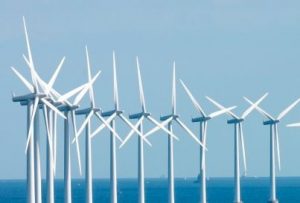
OCEAN CITY – Offshore wind farm designated areas off the mid-Atlantic coast could be expanding in the future after federal officials last week announced eight draft wind energy areas have been identified and are now open to a public comment period.
As part of the Biden administration’s stated goal of deploying 30 gigawatts of offshore wind energy capacity by 2030, the federal Bureau of Ocean Energy Management (BOEM) last week announced eight new draft Wind Energy Areas (WEAs) have been identified off the central U.S Atlantic coast and are now available for public review and comment.
The proposed offshore WEAs would cover roughly 1.7 million acres off the coast of from North Carolina to Delaware, including Maryland and the areas off the coast of Ocean City and Assateague, for example. The area’s closest points to the coast range from about 19 to 77 nautical miles.
That the new WEAs proposed by BOEM could be sited as far as 77 nautical miles off the resort coast appears to lend credence to the town of Ocean City’s argument the wind turbines could be sited further offshore and out of sight from the mid-Atlantic beaches. Two WEAs for projects far along in the planning pipeline or still pending are situated much closer to the resort coast.
From the beginning, Ocean City officials have not opposed offshore wind energy farms off the coast of the resort but have argued on multiple occasions the turbines should be located far enough from the shore that they would not be visible from the coast. Town officials have argued offshore wind turbines sited within Ocean City’s viewshed could have a detrimental impact on tourism and property values, for example.
For their part, the two offshore wind development companies with projects already approved by the Maryland Public Service Commission (PSC) have asserted their projects are well within the approved WEAs and the turbines would be situated as far off the resort coast as practical.
The eight draft WEAs from North Carolina to Delaware announced last week lie far outside the already approved WEAs for the most part. They represent a subset of a vast 3.9-million-acre call area that BOEM announced for public comment last April. BOEM Director Amanda Lefton said the opening of the public comment period for the eight draft WEAs announced last week represented the agency’s commitment to transparency in the process.
“As BOEM moves forward to identify wind energy areas in the central Atlantic, we continue to prioritize a robust and transparent process, including early engagement with tribal governments, state and federal agencies and ocean users,” she said. “We want to gather as much information and traditional knowledge as possible to help us identify Wind Energy Areas, the offshore area that are most suitable for commercial wind energy activities while having the fewest environmental and user conflicts.”
BOEM used a comprehensive process to identify potential offshore locations that appear most suitable for renewable energy development, taking into consideration possible impacts to local resources and ocean users, including, presumably, the commercial and recreational fishing industries. BOEM has collaborated with NOAA’s National Centers for Coastal Ocean Science to use an ocean planning model that seeks to minimize conflicts.
The final WEAs, after the close of the public comment period, may be modified after incorporating feedback from government partners, ocean users, and stakeholders. BOEM is seeking comment on potential conflicts within the draft areas, including with a potential U.S. Coast Guard fairway for transiting vessels, commercial fishing, a NASA danger zone and marine habitat areas, according to a release. BOEM intends to further explore the proposed WEAs with the Department of Defense, the U.S. Coast Guard, NASA and other ocean users such as the fishing industry to collect additional information that should be considered before finalizing the WEAs.
The proposed WEAs are separated by call areas with varying eastward and westward boundaries. Closest to home, Call Area A would begin about 20 nautical miles off the coast of Maryland and Delaware and extend eastward to the sea scallop rotational area and the Coast Guard’s port access route studies (PARS) or fairways for transiting vessels. Call Area A is adjacent to two approved lease areas immediately to the west on which multiple offshore wind projects are in the development process. It comprises of around 235 acres.
The boundary for Call Area B begins roughly 21 miles of the coast of Maryland and Virginia and extends eastward to the Coast Guard PARS, or fairways. Call Area B comprises approximately 652 acres.
The next step in BOEM’s renewable energy leasing process for the mid-Atlantic coast is a 30-day public comment period that began on Nov. 16. During the comment period, BOEM will hold virtual meetings to engage the fishing community and environmental organizations to gather more information on the WEAs and discuss the next steps.
To comment on the draft WEAs, go to regulations.gov and search for docket number BOEM-2022-0072. Comments will be accepted until midnight on Dec. 16.

